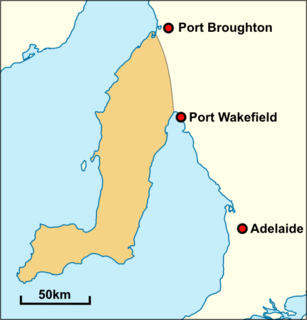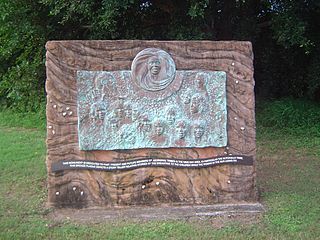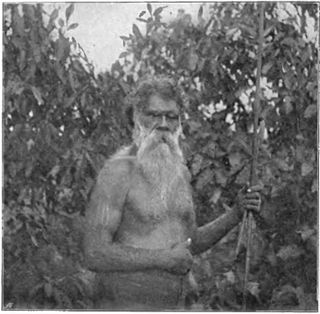The Diyari, alternatively transcribed as Dieri, is an Indigenous Australian group of the South Australian desert originating in and around the delta of Cooper Creek to the east of Lake Eyre.

The Wonnarua people, otherwise written Wanarruwa, are a group of Aboriginal Australian people united by strong ties of kinship, and who survived in family groups or clans scattered along the inland area of what is now known as the Upper Hunter Valley, New South Wales, Australia. Their creation spirit is Baiami, also known as Koin, the creator of all things and the Keeper of the Valley.

The Scone Advocate is an Australian local newspaper, serving the communities of Scone, Aberdeen and Murrurundi in the Upper Hunter Valley. It is owned by Australian Community Media, and goes on sale each Thursday for $1.40. The newspaper was founded in 1887, the same year Scone was declared a municipality.
Group 21 Rugby League is a local rugby league competition, run under the control of the Country Rugby League. It covers the Upper Hunter area of New South Wales, and has three divisions, first grade, reserves and Under 18s. For sponsorship reasons, it is known as the Bengalla Group 21 Competition.
The Gamilaraay, also known as Komeroi rendered Kamilaroi, Kamillaroi and other variations, are an Aboriginal Australian people whose lands extend from New South Wales to southern Queensland. They form one of the four largest Indigenous nations in Australia.

Alfred William Howitt, , also known by author abbreviation A.W. Howitt, was an Australian anthropologist, explorer and naturalist. He was known for leading the Victorian Relief Expedition, which set out to establish the fate of the ill-fated Burke and Wills expedition.

Kuringgai is an ethnonym referring to (a) an hypothesis regarding an aggregation of Indigenous Australian peoples occupying the territory between the southern borders of the Gamilaraay and the area around Sydney (b) perhaps an historical people with its own distinctive language, located in part of that territory, or (c) people of Aboriginal origin who identify themselves as descending from the original peoples denoted by (a) or (b) and who call themselves Guringai.

The Bidawal were an Australian Aboriginal tribe of Gippsland, Victoria. According to Alfred William Howitt, the Bidawal were composed of "refugees from tribes".
The Mirning, also known as the Ngandatha, are an Aboriginal Australian people whose traditional lands lay on the coastal region of the Great Australian Bight extending from Western Australia into south-west South Australia.

The Narungga people, also spelt Narangga, are a group of Aboriginal Australians whose traditional lands are located throughout Yorke Peninsula, South Australia. Their traditional language, one of the Yura-Thura grouping, is Narungga.
The Erawirung people, also known as Yirau, Juju and other names, were an Aboriginal Australian people whose traditional territory was located in what is today the Riverland of South Australia. They consisted of sub-groups or clans, including Jeraruk, Rankbirit and Wilu, and have been referred to as Meru people, which was a larger grouping which could also include the Ngawait and Ngaiawang peoples.

The Butchulla, also written Butchella, Badjala, Badjula, Badjela, Bajellah, Badtjala and Budjilla are an Aboriginal Australian people of K'gari, Queensland, and a small area of the nearby mainland of southern Queensland.

The Krauatungalung are an Indigenous Australian people, of East Gippsland, in the state of Victoria, Australia. They are regarded as a group of the Kurnai, though Tindale states that their inclusion as one of the Gunai is artificial.
The Brabiralung are an Indigenous Australian people, one of the five clans of Gippsland, in the state of Victoria, Australia, belonging to a wider regional grouping known as the Kurnai.
The Braiakaulung are an Indigenous Australian people, one of the five tribes of the Gunai/Kurnai nation, in the state of Victoria, Australia. They were recognized by Norman Tindale as an independent tribal grouping.
The Brataualung are an Indigenous Australian people, one of the five tribes of Gippsland, in the state of Victoria, Australia, and part of a wider regional grouping known as the Kurnai.
The Tatungalung are an indigenous Australian people of the state of Victoria. They are often, together with the Bratauolung, Braiakaulung, Brabiralung and Krauatungalung classified as belonging to one nation, the Gunai/Kurnai, though this typology has been thought, by Norman Tindale, to be an artificial construct.
The Antakirinja, otherwise spelt Antakarinya, and alternatively spoken of as the Ngonde, are an indigenous Australian people of South Australia.
The Warrgamay people, also spelt Warakamai, are an Aboriginal Australian people of the state of Queensland.
The Kaiabara are an indigenous Australian people of the state of Queensland. Rather than an independent tribe, they may have been a horde of the Wakka Wakka.